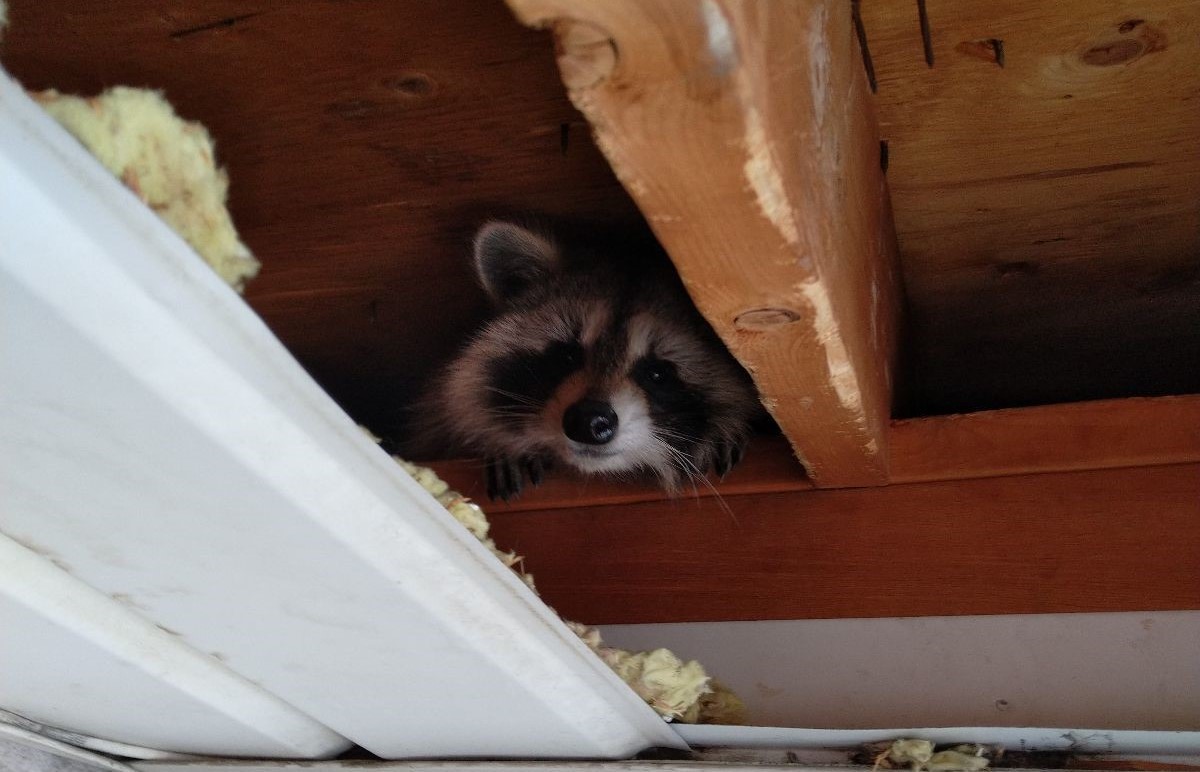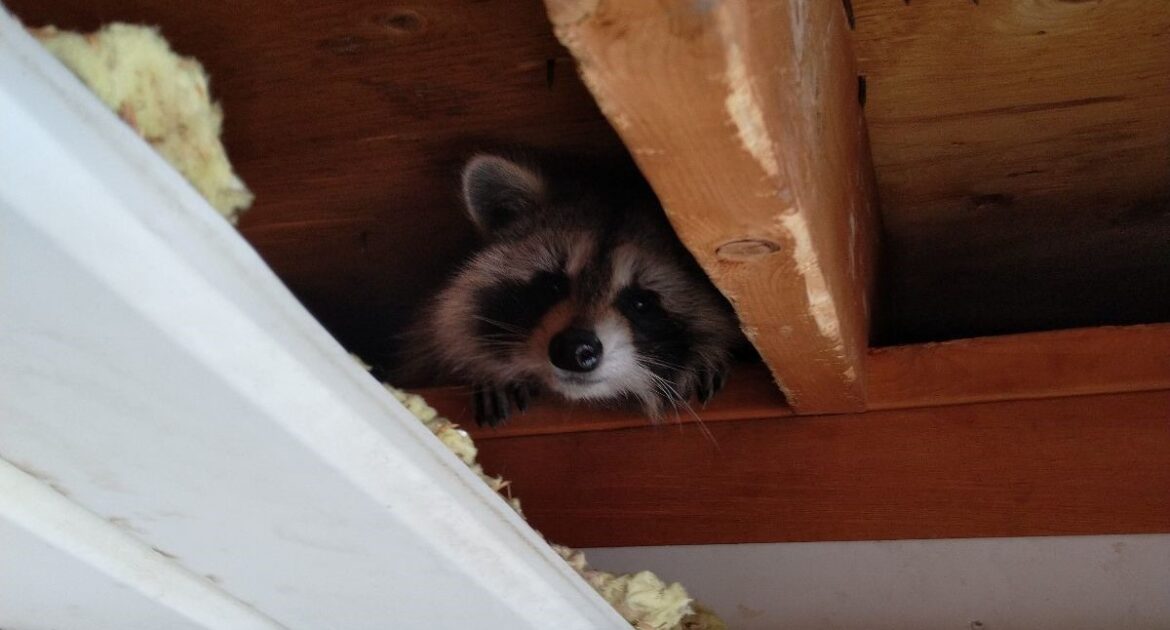Raccoons might look cute from a distance, but they can quickly become a serious nuisance when they find their way onto your property. Why are raccoons attracted to homes? Quite simply, your home offers everything they need to thrive. Food, shelter, and safety are the three main things raccoons are constantly searching for, and if your yard or house provides these, you could have uninvited guests before you know it. From unsecured trash bins to small gaps in your roofline, raccoons are incredibly skilled at spotting opportunities to invade your space and settle in.
If you’re wondering how to keep raccoons away, understanding what attracts them is the first step. Prevention is key to protecting your home and avoiding costly damage or health risks. At Skedaddle Humane Wildlife Control in North Atlanta, we specialize in humane removal methods and long-term prevention strategies. Through this guide, we’ll explore why raccoons are attracted to homes and share practical raccoon prevention tips for homeowners to help you safeguard your property.
Easy Meals Lure Them Close
Raccoons are scavengers with a sharp nose for food, and one of the main reasons why raccoons are attracted to homes is the convenience of easy meals. Whether it’s a trash bin left unsecured or birdseed scattered on the ground, any readily available food can draw raccoons to your yard. Once they discover a reliable food source, they’re likely to keep returning night after night.
Here are a few top food sources raccoons find irresistible:
- Trash bins: Loose lids or overfilled cans make it easy for raccoons to rummage through garbage for leftovers.
- Pet food: Outdoor feeding bowls are an open invitation, and raccoons won’t hesitate to raid them.
- Birdseed: Feeders often spill seeds onto the ground, making it an easy snack for raccoons.
- Fruit trees and gardens: Fallen fruit or unprotected vegetables attract raccoons, especially since they have a sweet tooth.
Raccoon Prevention Tips for Food Sources:
- Use durable garbage bins with tight-fitting or locking lids to keep raccoons out.
- Feed pets indoors whenever possible and clean up any spilled food promptly.
- Opt for bird feeders designed to reduce spillage and keep the ground beneath them clean.
- Regularly pick up fallen fruit from trees and consider using fencing to protect your garden.
Keeping food sources secure is one of the most effective steps you can take to keep raccoons away. A little effort to limit their access goes a long way in making your home less appealing.
Homes Provide Perfect Shelter
Raccoons aren’t just seeking food; they’re also searching for shelter. Your home might provide the perfect hiding spots where they can rest, stay protected, and even raise their young. Even small vulnerabilities, such as a loose shingle or broken vent, can become entry points.
Here are the most common hiding spots around homes:
- Attics: Raccoons love attics because they are warm, quiet, and out of reach from predators. With damaged roof vents or shingles, it’s easy for raccoons to climb in and make your attic their nesting site. Once inside, they’ll often tear up insulation to make their beds and may even bring in debris to build their nests, creating a mess that’s hard to clean.
- Chimneys: For raccoons, chimneys feel just like the hollow trees they often use in the wild. Without a secure chimney cap, raccoons can crawl right in and establish a shelter. They may even use the space to have their babies, and you could hear scratching or chattering noises from inside.
- Under decks and porches: The dark, hidden spaces beneath these structures act as safe havens, offering raccoons shelter from bad weather and predators. They’re especially drawn to these areas if they’re left open or have gaps where they can squeeze through. This can quickly lead to nesting behavior and repeated visits.
- Garages and sheds: A garage door left slightly open or a shed with gaps in the walls can provide raccoons with a welcoming hiding spot. These areas are quiet and offer protection, allowing them to sleep during the day with little risk of being disturbed. Over time, raccoons may scratch or damage these spaces further to make themselves more comfortable.
Raccoon Prevention Tips for Shelter:
- Inspect your roof regularly and seal any gaps or cracks. Repair broken vents or loose shingles immediately.
- Install sturdy chimney caps to keep raccoons and other wildlife out.
- Enclose open spaces beneath decks and porches with durable mesh or lattice.
- Ensure garages and sheds have no gaps or damage that could allow animals to get inside.
Since raccoons are excellent climbers and very persistent, checking for and addressing shelter opportunities is essential to keeping them off your property.
They Thrive in Dark, Quiet Spaces
Raccoons are nocturnal animals, which means they’re most active at night. During the day, they seek out dark, quiet areas to rest, and your home may offer the perfect environment for them to do so. Crawl spaces, attics, and even wall voids are often just what they’re looking for. Once they settle in, they might stick around for weeks or even months, especially if they’ve had babies.
Here are a few raccoon prevention tips for resting areas:
- Install motion-sensor lighting around your property to discourage nocturnal animals from exploring.
- Block access to crawl spaces with screens or barriers and inspect these areas regularly for signs of nesting.
- Seal gaps and cracks in walls, roofs, and foundations to eliminate potential entry points.
Encouraging raccoons to feel unwelcome during the hours they’re most active can greatly reduce the likelihood of them making your home their resting spot.
Signs of Raccoons in Your Home
Sometimes, raccoons move in quietly, and you won’t realize they’ve set up camp right away. Watching for certain signs can help you detect their presence early and take action before they cause further damage.
Look for the following warning signs around your home:
- Scratching or thumping noises at night coming from your attic or walls.
- Disturbed garbage, with bags ripped open or trash spilled around.
- Droppings left near your home, often in attics or close to entry points.
- Visible damage to your roof, chimney, vents, or screens.
If you notice any of these signs, don’t wait. Raccoons can cause structural damage, spread disease, and make existing entry points worse over time.
Why Raccoons Keep Coming Back
Even after addressing immediate problems, raccoons might return if your home still offers what they’re looking for. Raccoons have strong homing instincts and are clever enough to revisit a spot where they once found food or shelter.
Making your home unappealing to raccoons involves a combination of securing food sources, fixing potential entry points, and deterring them from your property altogether. However, some situations require professional help to fully resolve.
At Skedaddle Humane Wildlife Control in North Atlanta, we specialize in comprehensive and humane raccoon removal. Our process includes sealing entry points and using one-way doors that allow raccoons to leave your home but prevent them from coming back in. This ensures long-term solutions to keep your property raccoon-free.
Quick Raccoon Prevention Tips for Homeowners
Keeping raccoons away from your home doesn’t have to be complicated. By being proactive and securing your property, you can stop these clever critters from causing trouble. A few small changes can make a big difference in preventing raccoons from finding food, shelter, or resting spots around your house. Here are some quick and easy tips to help you protect your home and avoid unwanted visitors.
- Secure Trash Bins: Use strong lids or locking containers to keep raccoons out of your garbage.
- Seal Entry Points: Check for gaps or cracks in your roof, chimney, walls, or vents and make repairs quickly.
- Protect Outdoor Spaces: Install mesh barriers under decks and porches to block access.
- Remove Food Sources: Clean up fallen fruit, cover gardens, and feed pets indoors to avoid attracting raccoons.
- Install Chimney Caps: Use sturdy caps to prevent raccoons from climbing inside.
- Trim Tree Branches: Keep branches away from your roof to make it harder for raccoons to climb onto your home.
- Install Motion-Sensor Lights: Bright lights can deter raccoons from hanging around at night.
- Inspect Crawl Spaces: Regularly check and block entry to low-traffic areas where raccoons might rest.
Protecting Your Home for the Long Term
Raccoons might be clever and resourceful, but with the right prevention measures, you can outsmart them. By understanding why raccoons are attracted to homes and following these raccoon prevention tips for homeowners, you can create an environment that discourages them from sticking around. Securing food sources, shelter spots, and resting areas are the most important steps toward protecting your property from these determined invaders.
If you’re dealing with a raccoon problem or want to prevent future issues, we’re here to help. Our experienced team uses humane techniques like one-way doors to ensure that raccoons leave safely and stay out for good. Request an estimate today to learn more about how we can help make your home raccoon-free!




